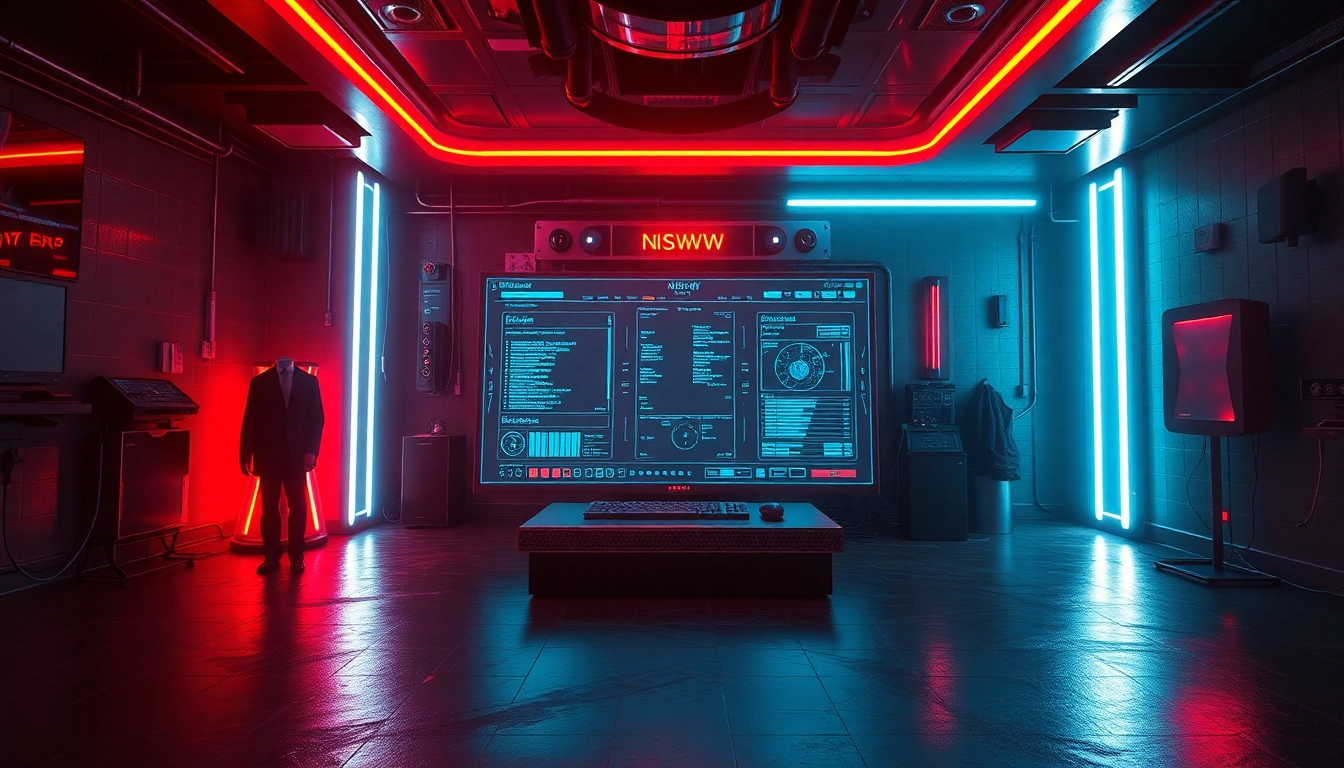Understanding the NSFW AI Generator Landscape in 2025
In recent years, advances in artificial intelligence (AI) have revolutionized creative and digital content creation, leading to the emergence of specialized tools like nsfw ai generator. As of 2025, this technology continues to evolve rapidly, expanding the possibilities for generating explicit images and videos that cater to adult audiences, creators, and industries seeking hyper-realistic or stylized content. The landscape is characterized by a myriad of tools, each with unique features, capabilities, and limitations. This comprehensive overview aims to dissect the current state of NSFW AI generators, highlighting popular tools, their functionalities, and the challenges faced within an ethically and legally complex environment.
Understanding the NSFW AI Generator Landscape in 2025
Overview of Popular Tools and Their Features
The proliferation of NSFW AI generators in 2025 is driven by innovative startups, established AI companies, and enthusiasts pushing the boundaries of digital content creation. Notable platforms include HeraHaven’s NSFW AI Image Generator, NSFWA Robotic Art, and Dream Companion, among others. These tools leverage deep learning, generative adversarial networks (GANs), and transformer models to produce highly detailed—sometimes hyper-realistic—images and videos from simple text prompts or rough sketches.
For instance, HeraHaven’s NSFW AI Image Generator allows users to input a descriptive prompt and generate customizable explicit images with control over style, pose, and details. NSFWA Robotic Art distinguishes itself by integrating style transfer capabilities, enabling creators to blend NSFW content with various artistic styles such as realism, anime, or abstract art. Dream Companion emphasizes interactivity, offering AI chatbots that simulate virtual encounters, generating personalized content based on user preferences.
These platforms generally fall into two categories: those focused on image and video generation, and those providing chat-based NSFW experiences. Key features across leading tools include:
- Customizability: Options to fine-tune the generated output based on prompts, style, or specific parameters.
- User interface: Intuitive and accessible interfaces that democratize content creation beyond technical experts.
- Output quality: High-resolution images and videos with realistic textures and details.
- Speed and efficiency: Rapid generation to support iterative workflows.
- Content moderation filters: Some platforms incorporate filters or safety measures to prevent misuse, although many still operate in a legally gray area.
Regulatory Challenges and Content Guidelines
Despite technological innovations, NSFW AI generators operate under a complex regulatory landscape. Different jurisdictions impose laws about the creation and distribution of adult content, especially when generated artificially. Platforms must navigate issues related to consent, privacy, and the potential for misuse, such as non-consensual deepfakes or image theft.
In many countries, AI-generated explicit content raises serious legal concerns, with regulations attempting to curb the proliferation of synthetic images that could be exploited for harassment or forgery. Content guidelines often restrict generating images of minors or non-consensual depictions, but enforcement remains challenging due to the decentralized and anonymized nature of many AI tools.
Notably, some platforms implement rigorous moderation and verification policies; others operate clandestinely or openly flout regulation, creating a split environment for users and developers. This ambiguity necessitates responsible usage and awareness of the legal implications associated with creating and sharing NSFW AI content.
How NSFW AI Generators Are Reshaping Digital Art
The infusion of AI into adult content creation significantly impacts digital art, enabling artists and enthusiasts to push creative boundaries while reducing costs and turnaround times. NSFW AI generators democratize access to high-quality explicit visuals: traditional art commissions or photography sessions can be expensive and time-consuming, but AI tools offer instant results based on detailed prompts.
Artists incorporate these tools into their workflows, blending AI-generated images with manual editing to produce stylized or hyper-realistic art assets. For example, some digital artists use AI to generate base images, then refine them with graphic design software, achieving results that were previously prohibitively labor-intensive.
Moreover, NSFW AI content fuels new forms of digital storytelling and community engagement, where users co-create narratives and characters, pushing the evolution of adult entertainment towards more interactive and personalized experiences.
Choosing the Right NSFW AI Generator for Your Needs
Factors to Consider: Quality, Speed, and Customization
Selecting an optimal NSFW AI generator depends heavily on individual needs and project goals. Fundamental factors include output quality, operational speed, and customization options. High-quality outputs with realistic textures, skin tones, and detailed backgrounds enhance believability and aesthetic appeal. Speed influences workflow efficiency, especially when generating multiple images or videos for commercial projects.
Customization is pivotal: the ability to craft specific poses, expressions, or styles allows for tailored content aligned with personal or brand identity. Tools like Dream Companion excel in delivering personalized outputs, whereas platforms with limited prompt flexibility may be suitable for simpler requirements.
Performance metrics such as rendering time, user interface responsiveness, and the resolution of final outputs should also guide selection. Feedback from user reviews and trials often offer insights into the platform’s stability and ease of use.
Evaluating User Experience and Accessibility
Beyond technical capabilities, user experience (UX) significantly impacts the practical adoption of NSFW AI tools. Intuitive interfaces with straightforward workflows lower entry barriers for new users. Platforms that support multi-platform access (web, mobile apps, desktop) further broaden accessibility.
Community support, tutorials, and customer service also enhance the user journey, ensuring users can troubleshoot issues and optimize their content creation processes. For instance, platforms offering comprehensive guides on prompt crafting or AI parameter tuning are often more successful in helping users unlock the full potential of the technology.
Legal and Ethical Implications in Using NSFW AI Tools
Legal and ethical considerations are central in the use of NSFW AI generators. Creating content that involves real individuals without consent, or generating images of minors and non-consensual depictions, is strictly illegal and unethical. Users must adhere to laws in their jurisdictions and platform policies to avoid penalties and reputational damage.
Practically, responsible users implement measures such as verifying input prompts, avoiding the use of real people’s images, and applying content moderation tools to prevent offensive or illegal outputs. Platforms that incorporate verification processes and community moderation help set standards for ethical content generation.
Educational outreach and self-regulation are essential components of responsible use, aimed at mitigating misuse while supporting creative expression within legal bounds.
Best Practices for Creating Safe and Responsible Content
Ensuring Consent and Privacy
While AI-generated explicit images often do not involve real individuals, scenarios mimicking or depicting real people demand meticulous care. Users should avoid inputting personal data or images of real persons unless explicit consent has been obtained. Developers and platform providers need to enforce strict policies against the misuse of AI tools for non-consensual content creation.
Tools should prioritize privacy, ensuring that user inputs and generated outputs are securely stored and not exploited. Transparency regarding data handling and content policies promotes user trust and aligns with ethical standards.
Implementing Content Moderation and Quality Control
Effective moderation mechanisms, such as automated filters, human oversight, and community reporting, are vital—not only to prevent illegal content but also to maintain platform integrity. Creators should verify that their generated content complies with platform guidelines and legal requirements. Techniques such as AI toxicity detection, nudity detection, and prompt filtering help uphold quality and responsibility.
Staying Compliant with Platform Policies and Laws
Adherence to platform policies and local laws is non-negotiable. Users must familiarize themselves with the legal landscape, which varies worldwide. For example, some jurisdictions prohibit AI-generated content that resembles minors or non-consensual depictions, while others have stricter regulations. Regular updates from platform providers regarding policy changes ensure compliance and mitigate risks.
Incorporating legal review as part of the content creation process ensures that users remain within the acceptable boundaries, fostering a responsible AI ecosystem.
Case Studies: Successful Applications of NSFW AI Generators
Creative Industries and Digital Art Portfolios
Some digital artists leverage NSFW AI tools to produce provocative art pieces that challenge traditional norms. In the fashion industry, designers experiment with AI-generated imagery to visualize avant-garde designs or erotic accessories, gaining recognition for innovative approaches. Online portfolios often feature AI-curated collections that blend human artistry with machine-generated elements, attracting niche audiences seeking unique adult content.
Adult Entertainment and Virtual Engagements
In the adult entertainment industry, NSFW AI enables the creation of virtual models and interactive experiences, reducing production costs and increasing personalization. Companies develop AI-driven chatbots and avatar-based platforms where users can engage with realistic virtual partners, enhancing user satisfaction and retention. The ability to generate tailored visuals and scenarios allows for subscription-based models and bespoke content creation.
Community Building and Content Personalization
Online communities centered around NSFW AI content foster shared creativity and exchange of prompts, techniques, and results. Platforms enable users to build personalized characters and avatars, which are then used in custom scenarios or shared within trusted groups. This nurtures niche communities while emphasizing responsible content sharing and moderation.
Future Trends and Innovations in NSFW AI Generation
Advancements in Realism and Style Diversity
The trajectory of NSFW AI technology points toward ultra-realistic content with unprecedented detail and nuance. Enhanced style diversity—ranging from hyper-realistic photography to stylized illustrations—will expand creative possibilities. Multi-modal models integrating text, images, and videos will offer multi-layered content generation, empowering creators to craft complex narratives seamlessly.
Integration with Virtual Reality and Interactive Platforms
The convergence of NSFW AI with virtual reality (VR) and augmented reality (AR) platforms heralds a new frontier for immersive experiences. Users will be able to interact with AI-generated avatars or scenes in real time, fostering personalized and engaging environments. Such integrations also pose new legal and ethical challenges, necessitating robust safeguards and moderation systems.
Emerging Market Opportunities and Challenges
Market expansion entails opportunities for entrepreneurs, startups, and established companies to develop specialized platforms and services. However, it also requires navigating complex legal frameworks, addressing societal concerns about consent, addiction, and exploitation. Future innovations must balance technological advancement with ethical responsibility to ensure sustainable growth.



